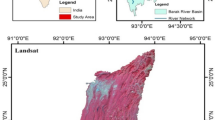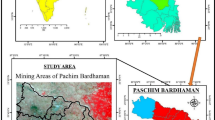Abstract
Surface excavation and overburden dumping in the Raniganj Coalfield have defaced the natural topography and impacted the hydrology. Excavation and dumping of overburden within the channels has obstructed streamflow and altered water availability in the lower parts of small catchment basins. The surface drainage paths of ephemeral channels and flow accumulation by channel networks was estimated from digital elevation remote sensing images using Arc Hydro Tools of Arc GIS software. The runoff from small basins was estimated using the US Soil Conservation Service Curve Number method and initial abstractions (depression storage) were estimated from CARTOSAT DEM satellite images using GIS techniques. In the studied area, 129 depressions (abandoned and working mines) were identified within 53 small basins over an area of more than 24 km2. The excavated areas arrest surface runoff, leading to degradation of downstream channels.
Zusammenfassung
Abgrabungen und Abraumverkippung im Raniganj Kohlefeld haben die natürliche Topographie beseitigt und die Hydrologie verändert. Abgrabung und Überkippung kleiner Fließgewässer behindern den Abfluss und veränderten die Wasserverfügbarkeit in den stromab gelegenen Teilen der Fließgewässer. Mit Hilfe des Arc Hydro Tools von Arc GIS wurden aus digitalen Fernerkundungsbildern und entsprechenden Höhenmodellen die Fließwege ephemeraler Bäche und deren zur Abflusskonzentration führenden Netzwerke ermittelt. Der Abfluss aus kleinen Teileinzugsgebieten wurde mit der US Soil Conservation Service Curve Number-Methode abgeschätzt. Der anfängliche Abflussrückhalt (Speicherung in Geländevertiefungen) wurde aus CARTOSAT DEM Satellitenbildern mittels GIS-Techniken abgeschätzt. Im untersuchten Gebiet mit mehr als 24 km2 Größe wurden 53 Kleineinzugsgebiete und darin insgesamt 129 Geländevertiefungen (stillgelegte und aktive Tagebaue) festgestellt. Der Rückhalt von Oberflächenabfluss im Bergbaugebiet führte zur Beeinträchtigung der stromab gelegenen Bachabschnitte.
Resumen
La excavación de superficie y las pilas de residuos en el campo de carbón Raniganj han desfigurado la topografía natural y ha impactado en la hidrología. La excavación y las pilas de residuos dentro de los canales han obstruido el flujo en los canales y han alterado la disponibilidad de agua en las partes más bajas de los pequeños reservorios de captación. Se estimaron las vías de drenaje de superficie de los canales efímeros y la acumulación de flujo por las redes de canales, utilizando imágenes digitales de sensores remotos con el software Arc Hydro Tools de Arc GIS. El escurrimiento desde los pequeños reservorios fue estimado usando el método de número de curva del servicio de conservación de suelos de US y las abstracciones iniciales (almacenamiento en la depresión) fueron estimadas con imágenes satelitales CARTOSAT DEM usando técnicas GIS. En el área estudiada, 129 depresiones (minas abandonadas y minas en actividad) fueron identificadas dentro de 53 pequeños reservorios en un área de más de 24 km2. Las áreas excavadas detienen la corriente superficial, lo que lleva a la degradación de los canales de aguas abajo.
摘要
Raniganj矿区露天矿的地表挖掘和覆岩转储破坏了天然地形,影响着当地水文条件。覆岩挖掘及其渠道倾卸阻碍了水流方向、截断了下游集水盆地水源。利用ArcGIS的Arc Hydro Tools工具处理数字高程遥感图像估算了暂时性河流的排泄路径及渠网的水流汇集。采用美国水土保持局(SCS)的径流曲线数模型估算小流域内径流,基于GIS的CARTOSAT DEM卫星图像估算了降水初损(田洼量)。在研究区超过24平方公里范围内的53个小流域中识别出129个洼地(包括废弃矿和生产矿井)。开挖区吸收地表径流、破坏下游渠道。.








Similar content being viewed by others
References
Bhadra A, Bandopadhyay A, Raghuwanshi NS, Sing R (2006) Development of a runoff prediction model using GIS-based SCS CN method in combination with Muskingum routing technique. In: Proceedings of 2nd international conf on hydrology and watershed management, B S Publ, Hyderabad, India, vol 1, p 250
Chandra S, Sharma KP (1978) Application of remote sensing to hydrology. In: Proceedings of symposium on hydrology of rivers with small and medium catchments, Univ of Roorkee, India, vol 2, pp 1–13
Chandra S, Sharma KP, Kashyap O (1984) Application of remote sensing methods to hydrology: watershed studies using simulation model for Upper Yamuna Catchments. School of Hydrology, Univ of Roorkee, India
Das SK, Chakrapani GJ (2010) Assessment of trace metal toxicity in soils of Raniganj Coalfield, India. Environ Monit Assess 177:63–71
Eastern Coalfield Limited (2011) Annual report. http://www.easterncoal.gov.in/annualreport/annualreport10-11.pdf
Eastern Coalfield Limited (2013) http://www.easterncoal.gov.in. Accessed 1 July 2013
Fiedler FR (2003) Simple, practical method for determining station weights using Thiessen polygons and isohyetal maps. J Hydrol Eng 8(4):219–221
Ghosh AK (1990) Mining in 2000 AD—challenges for India. J Inst Eng 39(ii):1–11
Hamon WR (1963) Computation of direct runoff amounts from storm rainfall, vol 63. IAHA Publ, Deakin, pp 52–62
Hawkins RH (1993) Asymptotic determinations of runoff curve numbers from data. J Irrig Drain E-ASCE 119(2):334–345
India Ministry of Agriculture and Co-operation (1972) Handbook of hydrology. Soil Conservation Dept, New Delhi
Koltun GF, Whitehead MT (2002) Techniques for estimating selected streamflow characteristics of rural, unregulated streams in Ohio. USGS Report FHWA/OH-2001/13, Columbus, OH, USA
Kumar P, Tiwart KN, Pal DK (1991) Establishing SCS runoff curve number from IRS digital data base. J Indian Soc Remote Sens 19(4):245–252
Lewis MJ, Singer MJ, Tate KW (2000) Applicability of SCS curve number method for a California Oak Woodlands Watershed. J Soil Water Conserv 53(2):226–230
Manna A, Maiti RK (2014) Opencast coal mining induced defaced topography of Raniganj Coalfield in India—remote sensing and GIS based analysis. J Indian Soc Remote Sens 42(4):755–764
Melnikov N, Chesnokov M (1969) Safety in opencast mining. Mir Publ, Moscow, Russia
Ragan RM, Jackson TJ (1980) Runoff synthesis using Landsat and SCS model. J Hydraulics Div ASCE 106(HY5):667–678
Ritter JB, Gardner TW (1991) Runoff curve numbers for reclaimed surface mines in Pennsylvania. J Irrig Drain Eng 117:656–666
Schwab GO, Fangmeier DD, Elliot WJ, Frevert RK (2002) Soil and water conservation engineering, 4th edn. Wiley, New York City, pp 34–35
Singh VP, Dickinson, WT (1975) A simple runoff model utilising soil moisture parameters. In: Proceedings of 2nd world congress, New Delhi vol 4, pp 355–364
Slack RB, Welch R (1980) Soil conservations service runoff curve number estimates from Landsat data. Water Resour Bull 16(5):887–893
Taylor TJ, Agouridis CT, Warner RC, Barton CD (2009) Runoff curve numbers for loose-dumped spoil in the Cumberland Plateau of eastern Kentucky. Int J Min Reclam Environ 23(2):103–120
US Soil Conservation Service (1969) Soil survey, Teton area. US Dept of Agriculture, Washington DC
US Soil Conservation Service (1972) Hydrology, national engineering handbook. Section 4. US Dept of Agriculture, Washington DC
Wong MH (2003) Ecological restoration of mine degraded soils, with emphasis on metal contaminated soils. Chemosphere 50:775–780
Younger PL, Wolkersdorfer C (2004) Mining impacts on the fresh water environment: technical and managerial guidelines for catchment scale management. Mine Water Environ 23(Suppl. 1):s2–s80
Acknowledgments
The authors thank the Council of Scientific and Industrial Research (CSIR), India for financial assistance (Research Fellowship). They also thank the European Digital Archive of Soil Maps and National Climatic Data Center, NOAA for providing soil and daily rainfall data, respectively. Last, but not least, efforts and suggestions from the editors and reviewers are highly appreciated.
Author information
Authors and Affiliations
Corresponding author
Electronic supplementary material
Below is the link to the electronic supplementary material.
Fig. 1
Satellite view of opencast mines (abandoned or working) (a) Abandoned opencast mine in the river bank; (b) Excavation decreases water availability in the lower Catchment; (c)Abandoned opencast mine obstructed channel flow; (d) Working opencast mine along the river bank (PDF 7971 kb)
Plate 1
(a) Abandoned opencast mine in the river bank; (b) Excavation decreases water availability in the lower Catchment; (c) Stagnation of polluted water in the abandoned opencast mine (PDF 4648 kb)
Table 1
Calculated Discharge volume of a Micro basin from Weighted CN (DOCX 17 kb)
Table 2
Basin wise retention volume and Runoff discharge volume from a single day maximum rainfall (DOCX 37 kb)
Rights and permissions
About this article
Cite this article
Manna, A., Maiti, R. Alteration of Surface Water Hydrology by Opencast Mining in the Raniganj Coalfield Area, India. Mine Water Environ 35, 156–167 (2016). https://doi.org/10.1007/s10230-015-0342-8
Received:
Accepted:
Published:
Issue Date:
DOI: https://doi.org/10.1007/s10230-015-0342-8




